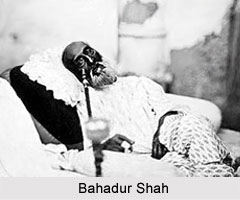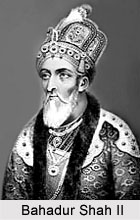 Abu Zafar Sirajuddin Muhammad Bahadur Shah Zafar, otherwise known as Bahadur Shah II or simply Bahadur Shah was the last of the Mughal emperors in India. He was born on October 24, 1775 and was the son of Akbar Shah II and his Hindu wife Lalbai. When Akbar Shah II died on September 28 in the year 1838, he ascended the throne. Bahadur Shah II had four wives. In the chronological order of marriage they are Begum Ashraf Mahal, Begum Akhtar Mahal, Begum Zeenat Mahal and Begum Taj Mahal. At least three "lines of descent" from Bahadur Shah Zafar are known. His Delhi line son is Mirza Fathul Mulk Bahadur (alias Mirza Fakhru) and grandson is Mirza Farkhunda Jamal. The great grandchildren are Hamid Shah and Begum Qamar Sultan while the great great granddaughters (daughters of Begum Qamar Sultan) include Begum Tahira Sultan and Pakizah Sultan Begum. The Howrah line son is Jawan Bakht whose son is Jamshid Bakht. Mirza Muhammad Bedar Bakht (married Sultana Begum) is the great-grandson from the Howrah line. The Hyderabad line son is Mirza Quaish and grandson is Mirza Abdullah whose son is Mirza Pyare (married Habib Begum). The great great granddaughter of Bahadur Shah II from this line is Begum Laila Ummahani (married Yakub Habeebuddin Tucy).
Abu Zafar Sirajuddin Muhammad Bahadur Shah Zafar, otherwise known as Bahadur Shah II or simply Bahadur Shah was the last of the Mughal emperors in India. He was born on October 24, 1775 and was the son of Akbar Shah II and his Hindu wife Lalbai. When Akbar Shah II died on September 28 in the year 1838, he ascended the throne. Bahadur Shah II had four wives. In the chronological order of marriage they are Begum Ashraf Mahal, Begum Akhtar Mahal, Begum Zeenat Mahal and Begum Taj Mahal. At least three "lines of descent" from Bahadur Shah Zafar are known. His Delhi line son is Mirza Fathul Mulk Bahadur (alias Mirza Fakhru) and grandson is Mirza Farkhunda Jamal. The great grandchildren are Hamid Shah and Begum Qamar Sultan while the great great granddaughters (daughters of Begum Qamar Sultan) include Begum Tahira Sultan and Pakizah Sultan Begum. The Howrah line son is Jawan Bakht whose son is Jamshid Bakht. Mirza Muhammad Bedar Bakht (married Sultana Begum) is the great-grandson from the Howrah line. The Hyderabad line son is Mirza Quaish and grandson is Mirza Abdullah whose son is Mirza Pyare (married Habib Begum). The great great granddaughter of Bahadur Shah II from this line is Begum Laila Ummahani (married Yakub Habeebuddin Tucy).
Emperor Bahadur Shah II ruled over a Mughal empire whose expanse was not much.
It hardly stretched beyond the modern city of Delhi. This is primarily because at that time of the nineteenth century, the then India was divided among many minor kings. The Sikh Empire in the Punjab and Kashmir, the Maratha Empire, and the British Empire were the principal military and political powers then. The emperor was subordinated to the British rule. The British gave him the power to draw a pension and bestowed upon him the authority to collect some taxes, and keep a small force in Delhi. Unlike some of the other Mughal emperors, Bahadur Shah II was not a significant threat to any power in India. He was neither exceptionally skilled in statecraft nor possessed royal ambitions. With the spread of the Indian rebellion of 1857, Indian regiments took possession of Delhi. In search of a figure that could bring together all Indians, irrespective of whether they are Hindus and Muslims, most insurgent Indian kings and the Indian regiments established Zafar as the Emperor of India. It was planned that under him the smaller Indian kingdoms would unite in order to defeat the British. Zafar was the least aggressive and the least ambitious of sovereigns, and the birthright of the Mughal Empire was more tolerable as a uniting force to most allied kings than the authority of any other Indian kingdom.
 When the uprising was trampled, Bahadur Shah II fled and took refuge in Humayun`s Tomb. However, the British soon took him into custody. Major Hodson put his sons Mirza Mughal and Khizar Sultan and his grandson Abu Bakr to death in his presence. Then their detached heads were offered to him in dishes instead of his food. He courageously said to the British that this was the way that the sons of Mughals came to their fathers - "with their heads in red". He was exiled to Rangoon (now known as Burma) in 1858 along with his wife Zeenat Mahal and the other members of the family. This drew the final line to the reign of the Mughal Dynasty that commenced with Babur in 1526. In 1877, the title Emperor of India was assumed by the reigning British ruler, who at that point was Queen Victoria. After his death on November 7, 1862, he was buried near Shwedagon Pagoda in Rangoon. His burial site later came to be known as Bahadur Shah Zafar Dargah.
When the uprising was trampled, Bahadur Shah II fled and took refuge in Humayun`s Tomb. However, the British soon took him into custody. Major Hodson put his sons Mirza Mughal and Khizar Sultan and his grandson Abu Bakr to death in his presence. Then their detached heads were offered to him in dishes instead of his food. He courageously said to the British that this was the way that the sons of Mughals came to their fathers - "with their heads in red". He was exiled to Rangoon (now known as Burma) in 1858 along with his wife Zeenat Mahal and the other members of the family. This drew the final line to the reign of the Mughal Dynasty that commenced with Babur in 1526. In 1877, the title Emperor of India was assumed by the reigning British ruler, who at that point was Queen Victoria. After his death on November 7, 1862, he was buried near Shwedagon Pagoda in Rangoon. His burial site later came to be known as Bahadur Shah Zafar Dargah.
Bahadur Shah II was also one of the supreme Urdu poets in Indian history. He composed a large number of Urdu Ghazals and Urdu poetry. A large portion was lost and damaged during the turmoil of 1857- 1858. A large portion is still extent, which was later on, compiled as Kulliyyat- i Zafar. Modern India has esteemed him as one of the first Indian rulers to raise a voice against the foreign rule of the British in the Indian soil. Several movies in Hindi and Urdu were made portraying him as a hero during the rebellion. Some of the streets in the country bear his name. Two of them are Bahadur Shah Zafar Marg in New Delhi and Bahadur Shah Zafar Road in Lahore in Pakistan. A statue of Bahadur Shah Zafar has been constructed at Vijayanagram Palace at Bhelupura in Varanasi. The road extending from Bhelupura Police Station to Durgakund Tank also bears the name of Bahadur Shah Zafar Marg. Since1959, an academy known as All India Bahadur Shah Zafar Academy has been endeavouring to spread among the people of India the knowledge of his involvement in the first national freedom movement of India.
In Bangladesh, the Victoria Park of old Dhaka has been renamed as Bahadur Shah Zafar Park as a token of the reverence that lies for him deep within the hearts of the Bangladeshis.
Bahadur Shah II was in fact a "warrior poet". In spite of having no towering imperial ambitions, he was one of the first to oppose foreign rule in India. He was also a literary artist. He wrote a poem that was to be his own epitaph.
The English translation goes thus:
•"My heart is not happy in this despoiled land
•Who has ever felt fulfilled in this transient world
•Tell these emotions to go dwell elsewhere
•Where is there space for them in this besmirched (bloodied) heart?
•The nighthingale laments neither to the gardener nor to the hunter
•Imprisonment was written in fate in the season of spring
•I had requested for a long life a life of four days
•Two passed by in pining, and two in waiting.
•How unlucky is Zafar! For burial
•Even two yards of land were not to be had, in the land (of the) beloved."
•Another of the verses reads:
•"Zafar, no matter how smart and witty one may be, he is not a man
•Who in good times forgot God, and who in anger did not fear Him."



















